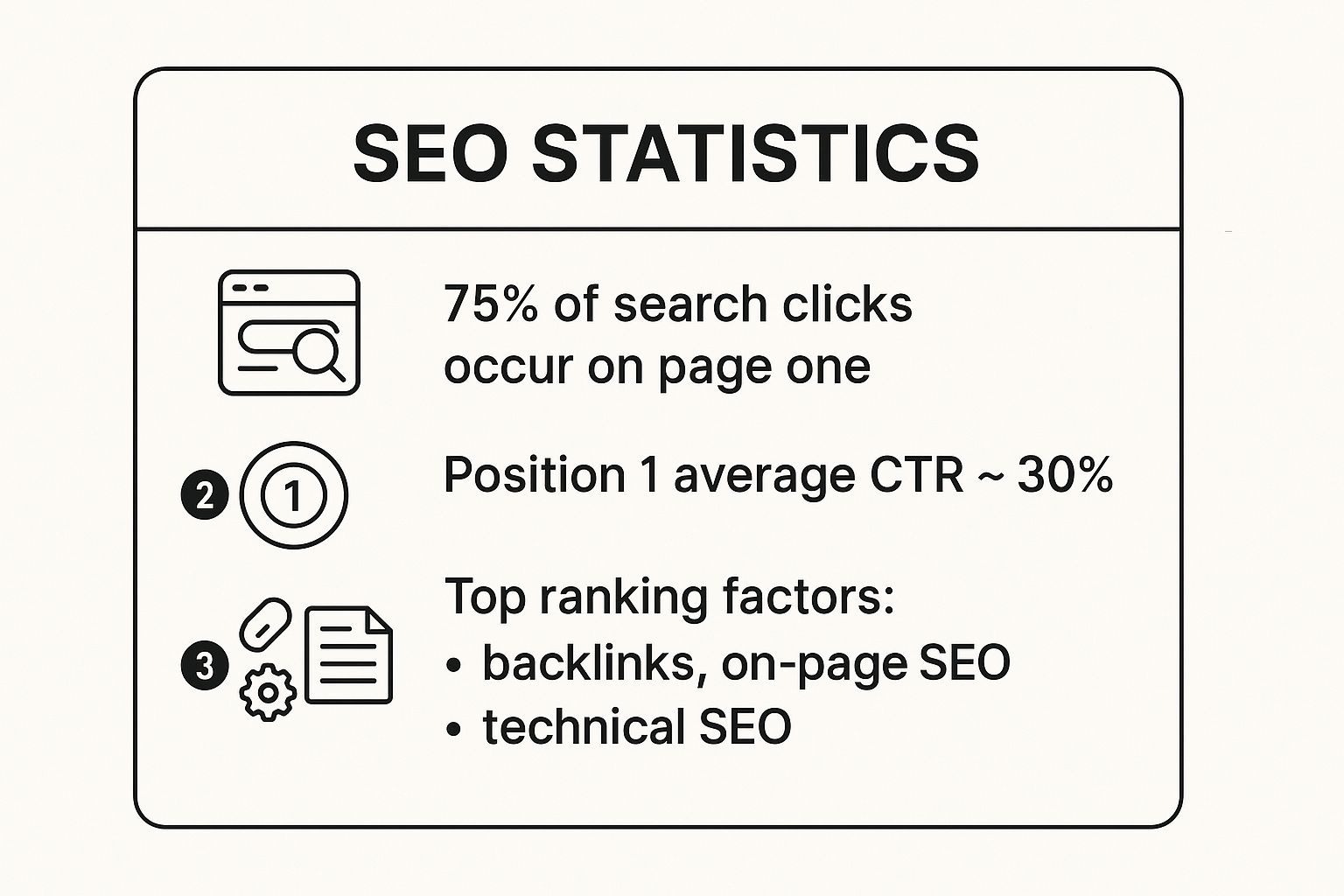Trying to improve your search engine rankings can feel like hitting a moving target. The old tricks—like keyword stuffing and chasing algorithm loopholes—no longer work. If you’re still playing that game, you’re falling behind.
The most effective path to sustainable visibility on search engine results pages (SERPs) rests on a powerful trio: high-value content, strategic internal linking, and sharp, data-driven optimization. Get these three elements working together, and you’ll create a growth flywheel that drives consistent results.
Your Modern SEO Success Framework
Think of your SEO strategy as a three-legged stool. You need rock-solid content, an intelligent site structure, and a constant feedback loop from your analytics. If one leg is weak, the whole strategy becomes unstable.
This guide provides an actionable blueprint that works today. We’ll dig into how these three pillars support each other and how a tool like AIWU can become the central nervous system for your entire strategy, seamlessly connecting content creation, internal linking, and performance analysis.
Why SERP Placement Is a High-Stakes Game
Let’s be clear: the battle for the top spots on Google is intense for a reason. Higher rankings mean more visibility, more traffic, and greater credibility. The data shows just how much is on the line.

As you can see, almost all clicks happen on page one. Securing the number one position gives you a dominant share of all clicks for that search. Everything else is a distant second.
Content: The Foundation of Everything
At the core of any winning SEO strategy is exceptional content. It’s how you deliver real value to your audience and prove your expertise to Google.
This doesn’t mean 500-word fluff pieces. Depth and quality have a direct, measurable impact. Studies show that long-form content—think over 3,000 words—can generate three times more traffic and be shared four times more often than shorter articles.
This is where having the best SEO tools becomes a game-changer. Creating high-quality, long-form content is a huge time commitment. A tool like AIWU is built to solve this exact problem. Instead of taking days to write a single pillar post, you can generate a comprehensive, SEO-optimized draft in minutes. This frees up your team to focus on what humans do best: refining, adding unique insights, and promoting the final piece.
Actionable Takeaway: Your goal isn’t just to answer a question. It’s to provide the most comprehensive, authoritative, and helpful answer available. That’s how you build topical authority that both users and search engines reward.
To understand how these pieces fit together, this table breaks down the entire framework.
Core Pillars of Modern SEO Success
| Pillar | Primary Goal | How AIWU Solves This |
|---|---|---|
| High-Value Content | Build topical authority and user trust. | Generates long-form, SEO-optimized articles and pillar pages in minutes. |
| Strategic Internal Linking | Distribute “link equity” and guide users. | Automatically identifies and suggests relevant internal link opportunities. |
| Data-Driven Optimization | Identify what works and double down. | Uses integrated analytics to track performance and guide future content strategy. |
This framework creates a self-reinforcing cycle. Great content earns top rankings and drives traffic. Smart internal links spread that authority across your site, lifting other pages. And your analytics tell you exactly what to do next.
In the following sections, we’ll show you exactly how to execute each part of this strategy.
Create High-Quality Content with AI

Let’s be practical. The single biggest roadblock to better search rankings is the constant need for expert-level content. We’ve all been there—spending days, sometimes weeks, creating a single in-depth article.
This is where AI changes the game. It transforms the content bottleneck into your biggest advantage.
But let’s be crystal clear: this isn’t about pasting a generic chatbot’s output into WordPress. That’s a fast track to thin, soulless content that Google’s algorithms—which value real expertise—will ignore. The real win comes from a smarter workflow that uses AI as an expert research assistant and a powerful first-draft machine.
A specialized platform like AIWU is built for this. It’s not just a text generator; it’s a content strategy tool designed to help you produce expert-level articles that are already optimized for search.
From Generic Prompts to Intent-Driven Content
The secret to content that ranks is deeply understanding and satisfying what the searcher is really looking for. What is their core problem? What follow-up questions do they have? A generic AI prompt can’t answer this.
This is where a specialized tool makes all the difference.
AIWU, for example, doesn’t just ask for a keyword. It analyzes the top-ranking pages, figuring out what’s already winning in the SERPs. It identifies common themes, must-have subtopics, and “People Also Ask” questions that are critical for creating a comprehensive resource.
You’re not starting from a blank page; you’re starting with a data-backed blueprint designed to meet searcher intent. This is a massive shortcut to improving search engine rankings.
Scale Your Content Production Without Sacrificing Quality
For years, marketers faced an impossible choice: quality or quantity? Pour a month into one perfect pillar page, or pump out several less-effective posts? With a smart AI workflow, you don’t have to choose.
You can maintain an incredibly high standard of quality while radically increasing your publishing velocity.
- Practical Example: Imagine you need to create a pillar page and five supporting articles for a new service. Manually, this could take a month or more. With AIWU, you can generate the first draft of the entire cluster in an afternoon.
- Pillar Pages: Generate a 3,000-word foundational article on a core topic.
- Topic Clusters: Quickly build out all supporting articles, creating a dense web of content that signals “topical authority” to Google.
- Blog Refreshes: Breathe new life into aging content with updated information to reclaim lost rankings.
AIWU’s bulk generation feature shows how you can line up an entire queue of long-form articles at once.

This screenshot demonstrates the power of turning content creation into a scalable system. You can methodically build out entire topic clusters, reinforcing your site’s expertise in a way that search engines reward.
Best Practice: Let AI handle 80% of the content creation grunt work—the research and drafting. This frees you, the human expert, to focus on the critical 20%: adding your unique insights, personal stories, and brand voice.
Customize Tone and Maintain Your Brand Voice
A common and valid fear with AI content is that everything will sound robotic and generic, erasing the brand voice you worked hard to build.
Thankfully, modern AI platforms are designed to solve this.
AIWU lets you define a custom personality for your AI writer. You can specify the exact tone (e.g., expert, witty, professional), the point of view, and even provide examples of your existing content for it to learn your style.
This control ensures that every article, from a deep technical guide to a lighthearted blog post, sounds like it came from you. It builds your brand’s authority with every piece you publish, creating a consistent and trustworthy experience. For anyone wanting to apply these ideas, you can start by mastering SEO on WordPress with this friendly guide.
By combining deep SERP analysis, scalable production, and true brand voice customization, you can finally solve the content challenge. You get the quality that users and search engines demand, with the speed you need to build authority and dominate your niche.
Build a Powerful Internal Linking Structure

If high-quality content is the engine of your SEO strategy, internal links are the roads that distribute its power across your website. They are a massively underrated tool for improving search engine rankings.
A smart internal linking structure does two critical things:
- It helps search engine crawlers discover all of your content.
- It guides your readers to find more valuable information, improving their experience.
Unfortunately, most site owners treat internal linking as an afterthought, dropping a random link here or there without a system. This haphazard approach leaves SEO potential on the table and creates “orphan pages”—valuable articles with no internal links, making them nearly invisible to Google.
Adopt the Pillar and Cluster Model
The most effective way to structure site authority is with the pillar page and topic cluster model. This isn’t just theory; it’s a practical blueprint for signaling to search engines that you are a genuine expert on a subject.
- Real-World Use Case: Imagine you run a blog about home gardening.
- Your Pillar Page: You create a massive, in-depth guide titled “The Ultimate Guide to Urban Vegetable Gardening.” This is your pillar, covering the topic broadly.
- Your Cluster Content: You then write several focused articles like “Best Vegetables for Container Gardens,” “How to Build a Balcony Herb Garden,” and “Solving Common Garden Pest Problems Naturally.”
- The Linking Strategy: You link from each of these smaller “cluster” articles back up to your main pillar page. You also link between the cluster articles where it makes sense.
This creates a tightly woven web of content around a central theme. For Google, this is a massive signal of topical authority. It sees a comprehensive, organized resource worth ranking, not just a dozen disconnected articles.
Automate Your Linking Opportunities with AI
Let’s be honest: manually building a pillar and cluster model across a site with hundreds of articles is a huge task. Finding the perfect, contextually relevant spot to add each link is incredibly time-consuming.
This is where a tool like AIWU becomes your secret weapon.
AIWU actively scans your entire library of published content. As you write a new article, it automatically surfaces relevant internal linking opportunities from your existing posts. This single feature solves the orphan page problem and ensures your new content is immediately woven into your site’s architecture, saving you hours of manual work.
The screenshot below shows exactly how AIWU suggests relevant anchor text and the source article to link from, turning a tedious task into a one-click action.

This automated process lets you build a powerful site structure without spending hours hunting for linking chances.
Best Practices for Anchor Text Optimization
The text you use for your links, known as anchor text, is a direct signal to search engines about the linked page’s topic. Getting this right is crucial.
Actionable Step: Avoid generic anchor text like “click here” or “read more” at all costs. These phrases provide zero contextual value and are a huge missed opportunity.
Instead, your anchor text should be descriptive and use natural variations of the target page’s main keyword.
- Poor Anchor Text: “To learn more about dog food, click here.”
- Good Anchor Text: “Choosing the right nutrition is vital, and there are many healthy dog treats for training.”
- Excellent Anchor Text: “While training your puppy, using low-calorie organic dog treats can support their diet.”
Notice how the better examples feel natural and provide clear context? AIWU helps here too by suggesting relevant and varied anchor text, preventing over-optimization with the exact same keyword every time, which can look spammy to search engines.
By building a thoughtful, strategic internal linking web, you distribute authority, improve the user experience, and create a site structure that Google loves to reward with higher rankings.
Use Analytics to Optimize Your Content Strategy
Creating great content and building smart internal links are huge wins. But without a feedback loop, you’re still flying blind. You need to know what’s working, what isn’t, and where your next big opportunity lies. This is where analytics stops being about vanity metrics and starts driving real, measurable growth.
Making data-backed decisions is the final piece of the puzzle for consistently improving your search engine rankings. It’s how you turn your content efforts into a repeatable system for success.
The goal is to stop guessing. Instead of wondering if an article is performing well, you’ll know exactly which keywords it’s ranking for, how much traffic it’s bringing in, and whether that traffic is valuable. AIWU’s integration with Google Search Console solves this by pulling critical performance data right into your WordPress dashboard where you need it most.
Moving Beyond Vanity Metrics
It’s easy to get caught up chasing page views. But high traffic on an irrelevant article that doesn’t convert is just noise. To sharpen your strategy, focus on the metrics that signal genuine progress.
A clear picture of your content’s performance is built on a handful of key metrics. These numbers tell you what’s truly working with both your audience and the search engines.
Key Performance Metrics for Content Optimization
A breakdown of essential metrics to track for evaluating and improving your content’s SEO performance.
| Metric | What It Measures | Why It’s Important for Rankings |
|---|---|---|
| Keyword Position | Your content’s rank in the SERPs for specific queries. | The most direct indicator of SEO success. Moving up in the rankings directly correlates to more visibility and traffic. |
| Click-Through Rate (CTR) | The percentage of people who click your link after seeing it in search results. | A high CTR signals to Google that your title and description are compelling and relevant, which can boost rankings. |
| Impressions | The total number of times your content appeared in search results. | High impressions mean Google sees your content as relevant for a range of queries. Spikes can indicate new ranking opportunities. |
| Conversions | Visitors who take a desired action (e.g., sign up, purchase). | The ultimate measure of content value. It proves your content attracts the right audience and persuades them to act. |
Focusing on these data points gives you a much more actionable understanding of your content’s health. Understanding how to track these outcomes is crucial for all your digital marketing, from setting up conversion tracking for digital campaigns to monitoring on-site goals.
Real-World Walkthrough: Pinpointing and Refreshing Content
Let’s make this practical. Imagine you published an article six months ago on “best cold brew coffee makers.” It did well, but now its traffic is declining. Here’s how you’d diagnose and fix it with a data-first approach using AIWU.
First, you pull up its performance right inside AIWU’s analytics dashboard, which syncs with your Google Search Console data.
The dashboard immediately shows the problem: your main keyword has slipped from page one to page two, and your CTR has dropped. That’s your signal to intervene.
Now, you can diagnose the cause:
- New Competitors: A few new, more comprehensive articles have jumped into the top 5.
- Outdated Info: Two coffee makers you recommended have been discontinued.
- Missed Keywords: Competitors are now ranking for long-tail terms like “quiet cold brew makers” and “best cold brew system for small kitchens,” which your article ignores.
Best Practice: Content decay is real. The trick is to catch it early and let data guide your refresh strategy. This turns a declining asset back into a top performer.
With this diagnosis, your next steps are clear. Use AIWU to run a fresh SERP analysis on your main keyword. The tool will instantly show you the new subtopics, “People Also Ask” questions, and missing keywords that top-ranking pages now cover.
From there, use the AI editor to refresh your article. Add new sections for the updated models and weave in the new long-tail keywords. In a short amount of time, you’ve transformed an underperforming post into a more comprehensive resource ready to climb back up the rankings.
This analytical approach is the foundation if you genuinely want to learn how to increase organic traffic and see lasting results.
Advanced Tactics for SERP Domination

You’ve built a solid foundation with quality content, smart internal links, and data-driven optimizations. That already puts you ahead of most competitors. But we’re not aiming for “most.” We’re aiming for SERP domination.
These next moves separate the sites that just rank from the ones that own the search results page. The goal is to capture as much SERP real estate as possible by strategically targeting rich results, using structured data, and pruning content that’s holding you back.
Target Featured Snippets and People Also Ask
That answer box at the very top of Google? That’s the Featured Snippet, or “Position Zero.” Landing this spot is a huge win. It can dramatically boost your visibility and click-through rate because it frames your content as the definitive answer.
The “People Also Ask” (PAA) section is a goldmine for understanding user intent. Ranking here is a powerful signal of your content’s relevance.
- Actionable Step: Structure your content to answer questions directly. Use an H2 or H3 subheading phrased as a question (e.g., “How Do You Clean a Coffee Maker?”). Immediately follow it with a clear, concise paragraph, a numbered list, or a bulleted list that answers the question.
- How AIWU Helps: When you generate an article with AIWU, it identifies “People Also Ask” questions from its SERP analysis. You can then instruct the AI to build dedicated sections that answer each one, spoon-feeding Google exactly what it wants for these SERP features.
By doing this, you’re not just hoping for a snippet; you are actively engineering your content to be featured. This is a proactive strategy for improving search engine rankings.
Best Practice: Treat every article as an opportunity to answer multiple questions. A clear question-and-answer format makes your content easy for Google to extract for Featured Snippets and PAA boxes.
Implement Structured Data for Richer Listings
Structured data (or Schema markup) is code you add to your site to give search engines more context about your content. It helps Google understand what your page is about, which can lead to rich results—those visually enhanced listings with ratings, images, and other info.
A plain search result is just a title, URL, and description. But a rich result for a recipe might show a star rating, cook time, and a photo. Rich results make your listing pop off the page and can significantly increase clicks.
While it sounds technical, AIWU automatically handles most of the essential markup for articles. If you want to dive deeper, our guide offers more insights into improving search engine rankings with advanced SEO techniques.
Conduct a Ruthless Content Audit
Not all of your content is a winner. Over time, pages become outdated, irrelevant, or simply fail to gain traction. These underperformers can dilute your site’s authority and waste Google’s crawl budget.
A content audit is where you systematically review every page and decide whether to keep, improve, or remove it.
- Keep: Your rockstar pages driving traffic and conversions.
- Improve: Pages with potential but are underperforming. These are perfect candidates for a content refresh.
- Remove: Pages with zero traffic, no backlinks, and no strategic value are dead weight. Delete them and set up a 301 redirect to a relevant, stronger page to pass along any lingering authority.
Regularly pruning your content ensures search engines see your best work, strengthening your site’s quality signals and focusing your SEO power where it counts.
As you implement these strategies, questions will arise. Climbing the search rankings is a continuous process of testing, learning, and refining. Here are straight answers to some of the most common questions.
“How Long Until I Actually See SEO Results?”
The honest answer is: it depends. SEO is a marathon, not a sprint. While you might see some quick wins, significant, lasting improvements in rankings usually take three to six months to become apparent. For highly competitive keywords, it could take a year or longer.
Factors that influence this timeline include:
- Your Starting Point: A brand-new site with no authority will take longer to build trust with Google than an established site with a solid backlink profile.
- Content Velocity: How quickly and consistently are you publishing helpful, optimized content? A site that regularly adds value will see results faster.
- Technical Health: A clean, fast, and mobile-friendly site provides a massive head start.
- Competition: Ranking for “local bakery in Boise” is a different challenge than “best CRM software.” The tougher the competition, the longer the climb.
Think of it like planting a garden. You prepare the soil (technical SEO), plant the right seeds (content), and water them consistently (linking and promotion). Patience is essential, but growth will come.
“Can AI-Generated Content Actually Rank on Google?”
Yes, absolutely—with a big caveat. AI-generated content can and does rank when it’s high-quality, helpful, and satisfies user intent. Google’s official stance is that they reward helpful content, regardless of how it was created. The problem isn’t the AI; it’s how it’s used.
Low-effort, generic AI content created to spam search results will fail. It lacks the depth, originality, and human experience that builds trust. Google’s systems are increasingly effective at devaluing this type of content.
But when you use a tool like AIWU as a co-pilot, the game changes. You guide the AI with data-driven outlines, custom instructions, and your own expertise. The AI does the heavy lifting—the research and drafting—while you provide the strategic direction and final human polish.
Best Practice: The secret to making AI content rank is ensuring it aligns with Google’s E-E-A-T (Experience, Expertise, Authoritativeness, Trustworthiness) guidelines. Your human oversight provides the experience and trust that generic AI output lacks.
By blending AI’s speed with your expert guidance, you create content that doesn’t just rank—it genuinely serves your audience.
“What Are the Most Critical Ranking Factors Today?”
Google’s algorithm has thousands of signals, but you don’t need to chase them all. Instead, focus on the core pillars that consistently move the needle for improving search engine rankings.
Today, success boils down to three key areas:
- Content Relevance and Quality: This is non-negotiable. Your content must be the best, most thorough answer to a user’s query. It needs to demonstrate expertise and cover the topic comprehensively.
- User Experience (UX) Signals: How people interact with your site sends powerful signals to Google. This includes page speed, mobile-friendliness, easy navigation, and low bounce rates. A great user experience tells Google your site is a valuable resource.
- Site Authority and Backlinks: Authority is earned over time by acquiring high-quality backlinks from other respected websites in your niche. These links act as votes of confidence, signaling to Google that your content is credible.
Imagine a three-legged stool. Brilliant content on a slow site with no backlinks will topple. A technically perfect site with thin content is just as wobbly. You need all three legs firmly in place for sustained success.
Ready to stop guessing and start building a predictable system for higher rankings? AIWU gives you the tools to create expert-level content, build a rock-solid internal link structure, and track what’s working—all from inside your WordPress dashboard. Check out AIWU here.

